Stop Script From Opening Again if Already Opened
Getting Started with Python in VS Lawmaking
In this tutorial, y'all use Python 3 to create the simplest Python "Hullo Earth" application in Visual Studio Code. Past using the Python extension, you lot make VS Code into a bully lightweight Python IDE (which you may find a productive alternative to PyCharm).
This tutorial introduces y'all to VS Code every bit a Python environment, primarily how to edit, run, and debug code through the following tasks:
- Write, run, and debug a Python "Hello World" Application
- Learn how to install packages by creating Python virtual environments
- Write a simple Python script to plot figures within VS Lawmaking
This tutorial is non intended to teach you Python itself. Once you are familiar with the basics of VS Code, you tin then follow whatever of the programming tutorials on python.org inside the context of VS Code for an introduction to the language.
If you take any issues, feel gratis to file an issue for this tutorial in the VS Code documentation repository.
Prerequisites
To successfully consummate this tutorial, you need to offset setup your Python development environment. Specifically, this tutorial requires:
- VS Lawmaking
- VS Lawmaking Python extension
- Python 3
Install Visual Studio Lawmaking and the Python Extension
-
If yous take not already done so, install VS Code.
-
Adjacent, install the Python extension for VS Lawmaking from the Visual Studio Marketplace. For additional details on installing extensions, see Extension Marketplace. The Python extension is named Python and it'due south published by Microsoft.
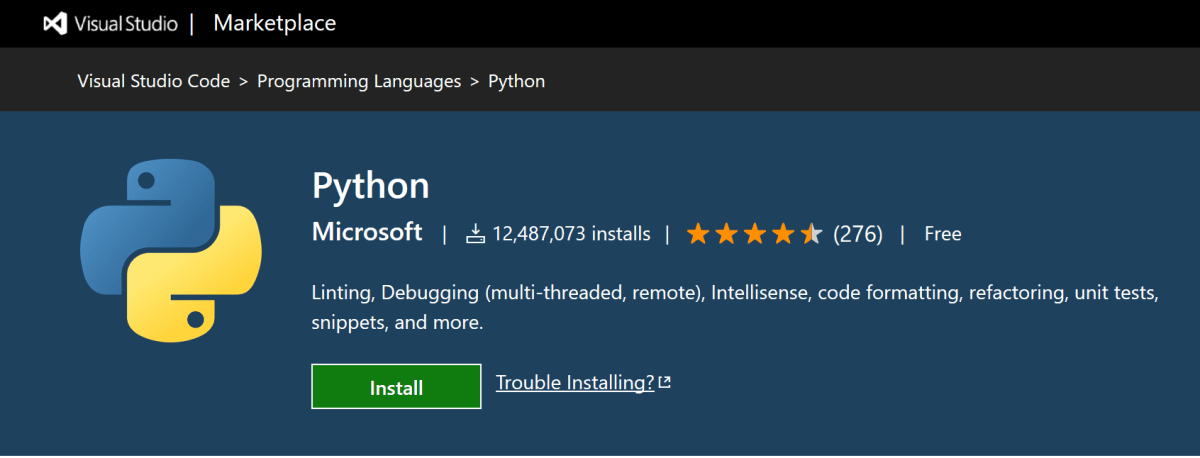
Install a Python interpreter
Along with the Python extension, you need to install a Python interpreter. Which interpreter yous use is dependent on your specific needs, but some guidance is provided below.
Windows
Install Python from python.org. You can typically utilise the Download Python button that appears starting time on the folio to download the latest version.
Annotation: If you don't have admin admission, an additional option for installing Python on Windows is to use the Microsoft Store. The Microsoft Shop provides installs of Python 3.7, Python 3.viii, Python 3.9, and Python 3.10. Be enlightened that you might take compatibility issues with some packages using this method.
For additional information about using Python on Windows, run across Using Python on Windows at Python.org
macOS
The system install of Python on macOS is not supported. Instead, an installation through Homebrew is recommended. To install Python using Homebrew on macOS use brew install python3 at the Terminal prompt.
Note On macOS, make certain the location of your VS Lawmaking installation is included in your PATH surroundings variable. See these setup instructions for more data.
Linux
The built-in Python 3 installation on Linux works well, merely to install other Python packages you must install pip with get-pip.py.
Other options
-
Data Science: If your primary purpose for using Python is Data Science, then you might consider a download from Anaconda. Anaconda provides not just a Python interpreter, just many useful libraries and tools for data scientific discipline.
-
Windows Subsystem for Linux: If yous are working on Windows and desire a Linux environment for working with Python, the Windows Subsystem for Linux (WSL) is an option for you lot. If you lot cull this selection, you'll also want to install the Remote - WSL extension. For more information about using WSL with VS Lawmaking, see VS Code Remote Evolution or effort the Working in WSL tutorial, which volition walk you through setting upwardly WSL, installing Python, and creating a Hello World application running in WSL.
Verify the Python installation
To verify that you've installed Python successfully on your auto, run one of the post-obit commands (depending on your operating organization):
-
Linux/macOS: open a Terminal Window and type the following command:
python3 --version -
Windows: open up a control prompt and run the following control:
py - 3 --version
If the installation was successful, the output window should testify the version of Python that y'all installed.
Note You tin utilize the
py -0command in the VS Code integrated terminal to view the versions of python installed on your machine. The default interpreter is identified by an asterisk (*).
Showtime VS Code in a project (workspace) folder
Using a command prompt or terminal, create an empty folder called "hello", navigate into it, and open VS Code (code) in that folder (.) by entering the following commands:
mkdir hi cd hello code . Annotation: If you lot're using an Anaconda distribution, exist certain to use an Anaconda command prompt.
By starting VS Lawmaking in a folder, that folder becomes your "workspace". VS Lawmaking stores settings that are specific to that workspace in .vscode/settings.json, which are dissever from user settings that are stored globally.
Alternately, you can run VS Code through the operating system UI, then use File > Open Binder to open the project folder.
Select a Python interpreter
Python is an interpreted language, and in social club to run Python lawmaking and go Python IntelliSense, you lot must tell VS Code which interpreter to use.
From inside VS Code, select a Python 3 interpreter by opening the Control Palette ( ⇧⌘P (Windows, Linux Ctrl+Shift+P)), start typing the Python: Select Interpreter command to search, then select the control. Y'all tin besides use the Select Python Environment option on the Condition Bar if bachelor (it may already show a selected interpreter, too):

The control presents a list of available interpreters that VS Code can notice automatically, including virtual environments. If you don't see the desired interpreter, meet Configuring Python environments.
Note: When using an Anaconda distribution, the right interpreter should have the suffix
('base':conda), for examplePython 3.7.iii 64-bit ('base of operations':conda).
Selecting an interpreter sets which interpreter volition be used by the Python extension for that workspace.
Notation: If y'all select an interpreter without a workspace binder open, VS Code sets
python.defaultInterpreterPathin User scope instead, which sets the default interpreter for VS Code in general. The user setting makes sure you always have a default interpreter for Python projects. The workspace settings lets you override the user setting.
Create a Python Hello Globe source code file
From the File Explorer toolbar, select the New File push on the hello folder:
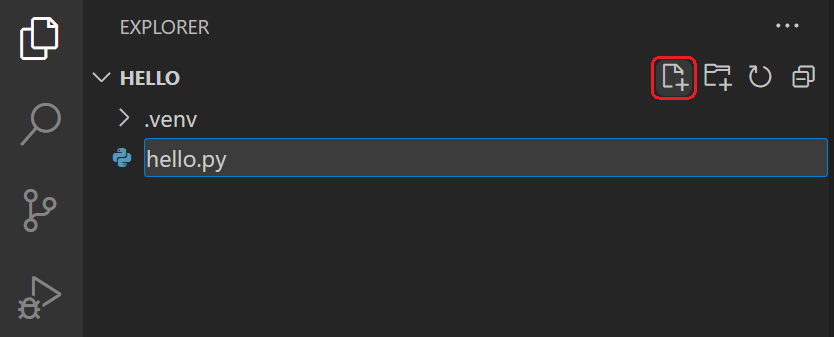
Name the file hello.py, and it automatically opens in the editor:
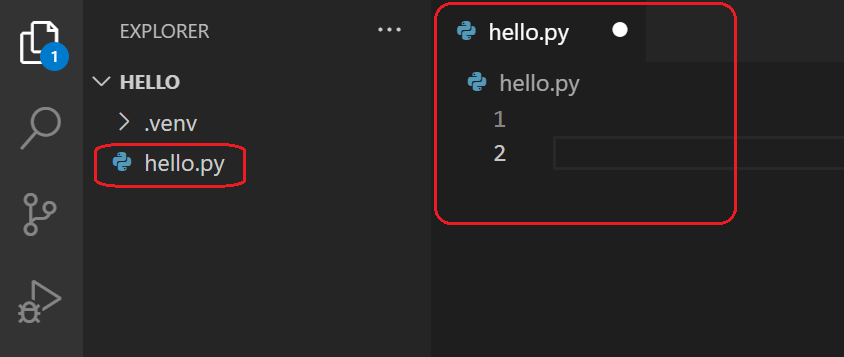
By using the .py file extension, y'all tell VS Code to interpret this file as a Python plan, then that information technology evaluates the contents with the Python extension and the selected interpreter.
Notation: The File Explorer toolbar also allows you lot to create folders inside your workspace to better organize your lawmaking. You can utilize the New folder button to quickly create a folder.
Now that you have a code file in your Workspace, enter the following source lawmaking in hello.py:
msg = "Hello Globe" impress (msg) When you first typing print, detect how IntelliSense presents auto-completion options.
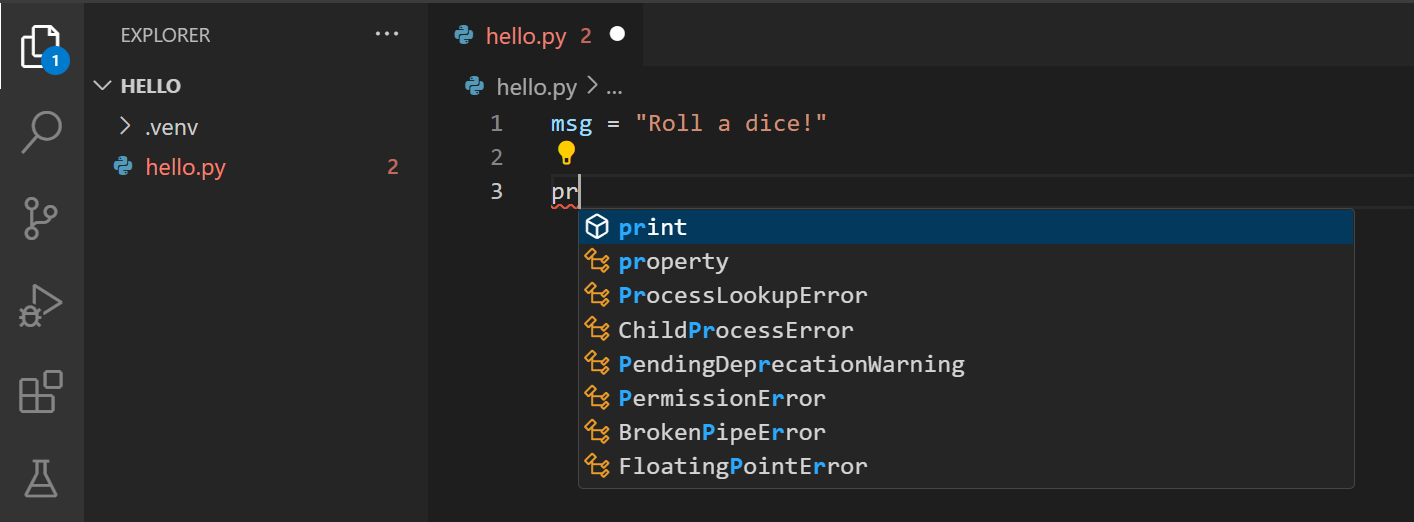
IntelliSense and auto-completions work for standard Python modules as well every bit other packages you've installed into the environment of the selected Python interpreter. Information technology likewise provides completions for methods bachelor on object types. For example, because the msg variable contains a string, IntelliSense provides string methods when you type msg.:
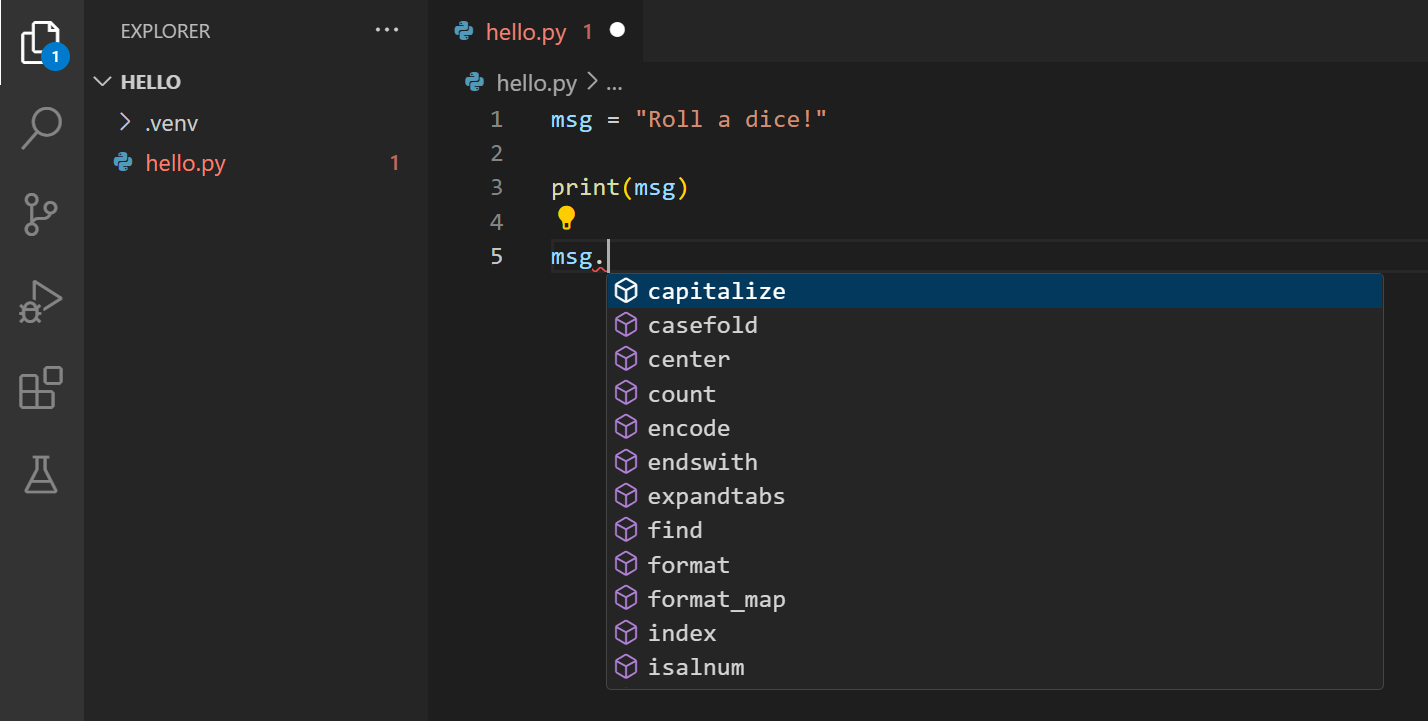
Feel free to experiment with IntelliSense some more, but then revert your changes so y'all have only the msg variable and the print call, and save the file ( ⌘S (Windows, Linux Ctrl+S)).
For full details on editing, formatting, and refactoring, come across Editing code. The Python extension also has total support for Linting.
Run Hello World
It's simple to run hullo.py with Python. Just click the Run Python File in Terminal play push in the top-right side of the editor.

The button opens a terminal panel in which your Python interpreter is automatically activated, so runs python3 hello.py (macOS/Linux) or python howdy.py (Windows):

At that place are three other ways you can run Python code within VS Code:
-
Correct-click anywhere in the editor window and select Run Python File in Last (which saves the file automatically):

-
Select one or more than lines, so printing Shift+Enter or right-click and select Run Selection/Line in Python Concluding. This control is convenient for testing just a function of a file.
-
From the Command Palette ( ⇧⌘P (Windows, Linux Ctrl+Shift+P)), select the Python: First REPL command to open a REPL terminal for the currently selected Python interpreter. In the REPL, you can and then enter and run lines of lawmaking one at a time.
Configure and run the debugger
Permit'south now try debugging our simple Hello Earth program.
Starting time, prepare a breakpoint on line 2 of howdy.py past placing the cursor on the print phone call and pressing F9 . Alternately, just click in the editor'south left gutter, next to the line numbers. When y'all set a breakpoint, a crimson circle appears in the gutter.
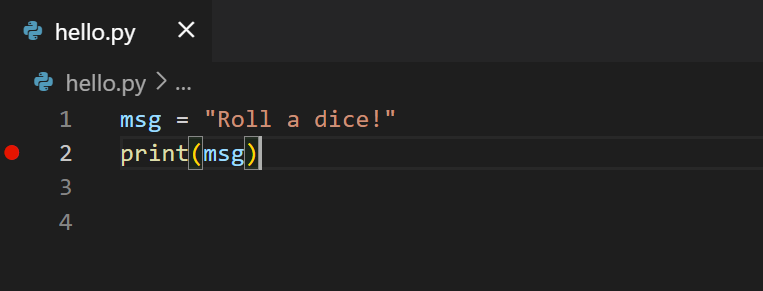
Side by side, to initialize the debugger, press F5 . Since this is your start time debugging this file, a configuration menu will open up from the Command Palette assuasive you to select the type of debug configuration you would like for the opened file.

Note: VS Code uses JSON files for all of its various configurations; launch.json is the standard name for a file containing debugging configurations.
These different configurations are fully explained in Debugging configurations; for at present, just select Python File, which is the configuration that runs the electric current file shown in the editor using the currently selected Python interpreter.
You tin can as well start the debugger by clicking on the downward-arrow next to the run button on the editor, and selecting Debug Python File in Terminal.

The debugger will stop at the first line of the file breakpoint. The current line is indicated with a yellow arrow in the left margin. If you examine the Local variables window at this point, you volition see at present divers msg variable appears in the Local pane.

A debug toolbar appears along the elevation with the post-obit commands from left to right: continue ( F5 ), step over ( F10 ), step into ( F11 ), step out ( ⇧F11 (Windows, Linux Shift+F11)), restart ( ⇧⌘F5 (Windows, Linux Ctrl+Shift+F5)), and end ( ⇧F5 (Windows, Linux Shift+F5)).

The Condition Bar also changes colour (orange in many themes) to indicate that you're in debug manner. The Python Debug Console also appears automatically in the lower right panel to evidence the commands existence run, along with the program output.
To continue running the plan, select the continue command on the debug toolbar ( F5 ). The debugger runs the program to the terminate.
Tip Debugging data tin can too exist seen by hovering over lawmaking, such as variables. In the example of
msg, hovering over the variable will brandish the cordHello worldin a box above the variable.
Y'all can too work with variables in the Debug Console (If you don't come across it, select Debug Panel in the lower right surface area of VS Lawmaking, or select it from the ... carte.) Then endeavour entering the following lines, one by i, at the > prompt at the bottom of the console:
msg msg.capitalize() msg.split() 
Select the blue Continue button on the toolbar again (or printing F5) to run the program to completion. "Hello Globe" appears in the Python Debug Console if you switch back to information technology, and VS Code exits debugging mode once the plan is complete.
If you restart the debugger, the debugger again stops on the first breakpoint.
To finish running a program earlier it'due south consummate, utilise the blood-red square stop button on the debug toolbar ( ⇧F5 (Windows, Linux Shift+F5)), or use the Run > Stop debugging menu command.
For full details, see Debugging configurations, which includes notes on how to use a specific Python interpreter for debugging.
Tip: Utilise Logpoints instead of print statements: Developers often litter source code with
Install and use packages
Let'due south at present run an example that'due south a little more interesting. In Python, packages are how you obtain any number of useful lawmaking libraries, typically from PyPI. For this instance, you utilise the matplotlib and numpy packages to create a graphical plot as is commonly done with data science. (Notation that matplotlib cannot show graphs when running in the Windows Subsystem for Linux as it lacks the necessary UI back up.)
Return to the Explorer view (the summit-nigh icon on the left side, which shows files), create a new file called standardplot.py, and paste in the post-obit source lawmaking:
import matplotlib.pyplot as plt import numpy as np x = np.linspace( 0 , xx , 100 ) # Create a list of evenly-spaced numbers over the range plt.plot(x, np.sin(ten)) # Plot the sine of each x betoken plt.testify() # Display the plot Tip: If you enter the above code past manus, yous may discover that auto-completions change the names after the
askeywords when you press Enter at the end of a line. To avoid this, type a space, then Enter.
Next, try running the file in the debugger using the "Python: Current file" configuration as described in the last section.
Unless you're using an Anaconda distribution or have previously installed the matplotlib package, you should encounter the message, "ModuleNotFoundError: No module named 'matplotlib'". Such a bulletin indicates that the required parcel isn't available in your system.
To install the matplotlib package (which also installs numpy as a dependency), finish the debugger and use the Command Palette to run Final: Create New Terminal ( ⌃⇧` (Windows, Linux Ctrl+Shift+`)). This command opens a command prompt for your selected interpreter.
A best practise among Python developers is to avoid installing packages into a global interpreter environment. You instead use a projection-specific virtual surround that contains a copy of a global interpreter. In one case you activate that environs, any packages you then install are isolated from other environments. Such isolation reduces many complications that can arise from conflicting package versions. To create a virtual surroundings and install the required packages, enter the following commands as appropriate for your operating system:
Note: For additional information about virtual environments, run into Environments.
-
Create and activate the virtual surroundings
Note: When y'all create a new virtual environs, you should be prompted past VS Lawmaking to fix information technology as the default for your workspace folder. If selected, the surroundings will automatically be activated when yous open up a new final.

For Windows
py -iii - 1000 venv .venv . venv \ scripts \ actuateIf the actuate control generates the bulletin "Activate.ps1 is not digitally signed. You lot cannot run this script on the current system.", then you need to temporarily change the PowerShell execution policy to allow scripts to run (see About Execution Policies in the PowerShell documentation):
Gear up - ExecutionPolicy - ExecutionPolicy RemoteSigned - Scope ProcessFor macOS/Linux
python3 -m venv .venv source .venv/bin/activate -
Select your new environment by using the Python: Select Interpreter control from the Control Palette.
-
Install the packages
# Don't use with Anaconda distributions because they include matplotlib already. # macOS python3 -m pip install matplotlib # Windows (may require pinnacle) python -m pip install matplotlib # Linux (Debian) apt-go install python3-tk python3 -m pip install matplotlib -
Rerun the program now (with or without the debugger) and after a few moments a plot window appears with the output:

-
Once you are finished, type
deactivatein the last window to conciliate the virtual environment.
For additional examples of creating and activating a virtual environment and installing packages, see the Django tutorial and the Flask tutorial.
Next steps
You tin configure VS Code to use any Python environs you take installed, including virtual and conda environments. You can likewise use a dissever environment for debugging. For full details, come across Environments.
To learn more than almost the Python language, follow whatever of the programming tutorials listed on python.org within the context of VS Code.
To learn to build spider web apps with the Django and Flask frameworks, see the following tutorials:
- Use Django in Visual Studio Lawmaking
- Use Flask in Visual Studio Code
In that location is then much more to explore with Python in Visual Studio Lawmaking:
- Editing code - Learn about autocomplete, IntelliSense, formatting, and refactoring for Python.
- Linting - Enable, configure, and utilise a variety of Python linters.
- Debugging - Learn to debug Python both locally and remotely.
- Testing - Configure test environments and find, run, and debug tests.
- Settings reference - Explore the full range of Python-related settings in VS Lawmaking.
- Deploy Python to Azure App Service using containers
- Deploy Python to Azure App Service on Linux
Source: https://code.visualstudio.com/docs/python/python-tutorial
0 Response to "Stop Script From Opening Again if Already Opened"
Post a Comment